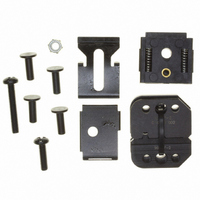90547-2 Tyco Electronics, 90547-2 Datasheet - Page 4

90547-2
Manufacturer Part Number
90547-2
Description
DIE SET 20-14 AWG .200 INS UNI
Manufacturer
Tyco Electronics
Series
Pro-Crimper™ III, Universal MATE-N-LOK®r
Type
Crimp Toolr
Datasheet
1.90547-1.pdf
(6 pages)
Specifications of 90547-2
Connector Type
Crimp Terminals
Crimp Handle
A9996-ND
Crimp Or Cable Size
14-20 AWG
Wire Size (awg)
20-14, 16-14
Universal Mate-n-lok Ii Pin & Socket Contacts
Crimp Application
Product
Crimping, Stripping & Cutting Tools & Drills
For Use With
354940-1 Pro-Crimper II Crimp Tool Frame
Lead Free Status / RoHS Status
Not applicable / Not applicable
Lead Free Status / RoHS Status
na, Not applicable / Not applicable
Other names
A9924
6. CRIMP HEIGHT INSPECTION
Crimp height inspection is performed through the use
of a micrometer with a modified anvil, commonly
referred to as a crimp--height comparator. Tyco
Electronics does not manufacture or market
crimp--height comparators. Detailed information on
obtaining and using crimp--height comparators can be
found in instruction sheet 408--7424.
Proceed as follows:
4 of 6
Position Point
on Center of
Wire Barrel
Opposite
Seam
Modified Anvil
AWG (Max)
Wire Size
Wire Size
5. Insert stripped wire into contact insulation and
wire barrels until it is butted against the wire stop,
as shown in Figure 3.
6. Holding the wire in place, squeeze tool handles
together until ratchet releases. Allow tool handles
to open and remove crimped contact.
NOTE
7. Check the contact’s crimp height as described in
Section 6, CRIMP HEIGHT INSPECTION. If
necessary, adjust the crimp height as described in
Section 7, RATCHET (Crimp Height)
ADJUSTMENT.
1. Refer to Figure 4 and select a wire (maximum
size) for each crimp section listed.
2. Refer to Section 5, CRIMPING PROCEDURE,
and crimp the contact(s) accordingly.
3. Using a crimp--height comparator, measure the
wire barrel crimp height as shown in Figure 4. If the
i
18
14
The crimped contact may stick in the crimping
area, but the contact can be easily removed by
pushing downward on the top of the locator (see
Figure 3).
(Wire Size Marking)
Crimp Section
Crimp Section
20--18
16--14
Figure 4
“A”
Dimension A and
Dimension A and
Crimp Height
Tolerance (+)
[.049 + .002]
[.063 + .002]
1.60 + .05
1.24 + .05
Tyco Electronics Corporation
7. RATCHET (Crimp Height) ADJUSTMENT
8. MAINTENANCE
Ensure that the tool and dies are clean by wiping
them with a clean, soft cloth. Remove any debris with
a clean, soft brush. Do not use objects that could
damage the tool. When not in use, keep handles
closed to prevent objects from becoming lodged in
the crimping dies, and store in a clean, dry area.
crimp height conforms to that shown in the table,
the tool is considered dimensionally correct. If not,
the tool must be adjusted. Refer to Section 7,
RATCHET (Crimp Height) ADJUSTMENT.
1. Remove the lockscrew from the ratchet
adjustment wheel.
2. With a screwdriver, adjust the ratchet wheel
from the locator side of the tool.
3. Observe the ratchet adjustment wheel. If a
tighter crimp is required, rotate the adjustment
wheel COUNTERCLOCKWISE to a
higher--numbered setting. If a looser crimp is
required, rotate the adjustment wheel
CLOCKWISE to a lower--numbered setting.
4. Replace the lockscrew.
5. Make a sample crimp and measure the crimp
height. If the dimension is acceptable, replace and
secure the lockscrew. If the dimension is
unacceptable, continue to adjust the ratchet, and
again measure a sample crimp.
Ratchet
Adjustment
Wheel
Screwdriver
Lockscrew
(Typ)
Figure 5
(Figure 5)
Rev C





